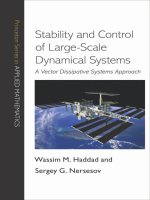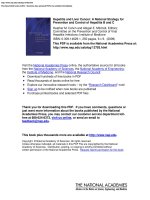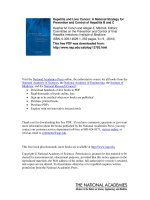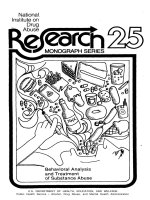Analysis and Control of Corn plex Nonlinear Processes pptx
Bạn đang xem bản rút gọn của tài liệu. Xem và tải ngay bản đầy đủ của tài liệu tại đây (23.74 MB, 453 trang )
Analysis and Control
of
Corn
plex Nonlinear Processes
in Physics, CHemistry and Biology
WORLD SCIENTIFIC LECTURE NOTES IN COMPLEX SYSTEMS
Editor-in-Chief:
AS.
Mikhailov,
Fritz Haber Institute, Berlin, Germany
H. Cerdeira,
ICTP, Triest,
Italy
B.
Huberman,
Hewlett-Packard, Palo
Alto,
USA
K. Kaneko,
University
of
Tokyo,
Japan
Ph.
Maini,
Oxford University, UK
AIMS AND SCOPE
The aim of this new interdisciplinary series is to promote the exchange of information
between scientists working in different fields, who are involved in the study of complex
systems, and to foster education and training of young scientists entering this rapidly
developing research area.
The scope of the series is broad and will include: Statistical physics of large
nonequilibrium systems; problems of nonlinear pattern formation in chemistry; complex
organization of intracellular processes and biochemical networks of a living cell; various
aspects
of
cell-to-cell communication; behaviour
of
bacterial colonies; neural networks;
functioning and organization of animal populations and large ecological systems;
modeling complex social phenomena; applications of statistical mechanics
to
studies
of economics and financial markets; multi-agent robotics and collective intelligence; the
emergence and evolution of large-scale communication networks; general mathemati-
cal studies
of
complex cooperative behaviour in large systems.
Published
Vol.
1
Vol.
2
Vol.
3
Vol.
4
Nonlinear Dynamics: From Lasers to Butterflies
Emergence of Dynamical Order: Synchronization Phenomena in
Complex Systems
Networks of Interacting Machines
Lecture Notes on Turbulence and Coherent Structures in Fluids,
Plasmas and Nonlinear Media
World
Scientific Lecture Notes
in Complex Systems
-
Vol.
5
Free University Berlin, Germany
University
of
Potsdam, Germany
Technical University Berlin, Germany
Analysis
and
Control
of
Complex
Nonlinear
Processes
World
Scientific
K
NEW JERSEY
*
LONDON
-
SINGAPORE BElJlNG
*
SHANGHAI
*
HDNG
KONG
TAIPEI
*
CHENNAI
editors
L. Schimansky-GGeier
B. Fiedler
J. Kurths
E. Scholi
Humboldt University, Berlin, Germany
in Physics, Chemistry and Biology
Published by
World Scientific Publishing Co. Re. Ltd.
5 Toh Tuck Link Singapore 596224
USA
ofice:
27 Warren Street, Suite 401-402, Hackensack,
NJ
07601
UK
ofice:
57 Shelton Street, Covent Garden, London WC2H 9HE
British Library Cataloguing-in-Publication Data
A
catalogue record for
this
book is available from the British Library.
World
Scientific Lecture Notes
in
Complex Systems
-
Vol.
5
ANALYSIS AND CONTROL
OF
COMPLEX NONLINEAR PROCESSES
IN
PHYSICS, CHEMISTRY AND BIOLOGY
Copyright
0
2007 by World Scientific Publishing Co. Re. Ltd.
All
rights reserved. This book, or parts thereoJ
may
not be reproduced
in
any
form
or
by
any means,
electronic or mechanical, including photocopying, recording or any information storage and retrieval
system now
known
or to be invented, without written permissionfrom the Publisher.
For
photocopying of material in this volume, please pay a copying fee through the Copyright
Clearance Center, Inc., 222 Rosewood Drive, Danvers,
MA
01923,
USA.
In this case permission to
photocopy
is
not required from the publisher.
ISBN-I3 978-981-270-583-9
ISBN-I0 981-270-583-X
Printed
by
FuIsland Offset Printing
(S)
Pte Ltd, Singapore
Dedicated to Werner Ebeling and Gerhard
Ertl
This page intentionally left blankThis page intentionally left blank
Preface
Nonlinear dynamics of complex processes is an active research field with
large numbers of publications in basic research and broad applications from
diverse fields
of
science. Nonlinear dynamics as manifested by determin-
istic and stochastic evolution models of complex behaviour has entered
statistical physics, physical chemistry, biophysics, geophysics, astrophysics,
theoretical ecology, semiconductor physics and -optics etc. This research
has induced a new terminology in science connected with new questions,
problems, solutions and methods. New scenarios have emerged for spatio-
temporal structures in dynamical systems far from equilibrium. Their anal-
ysis and possible control are intriguing and challenging aspects of the cur-
rent research.
The duality
of
fundamental and applied research is a focal point
of
its
main attractivity and fascination. Basic topics and foundations are always
linked to concrete and precise examples.
Models and measurements
of
complex nonlinear processes evoke and provoke new fundamental questions
and diversify and broaden the mathematical concepts and tools. In return,
new mathematical approaches to modeling and analysis enlarge the scope
and efficiency of applied research.
Fundamental research on complex physical systems, as well
as
applied in-
terdisciplinary investigations of nonlinear dynamics, are valued highly in
research programs and education
of
universities and research institutes in
Berlin and Potsdam (Germany). Initiated by Werner Ebeling (Humboldt-
University at Berlin) and Gerhard Ertl (Fritz Haber Institute Berlin) the
vii
viii
Preface
collaborative research has led to the foundation of the collaborative research
center
555
of the German research society (DFG),
9
years ago. This center
has stimulated cooperations between the different research groups in the
region.
Recent progress on nonlinear complex processes in Berlin and Potsdam is
presented in this volume. The topics of our research encompass
-
spatio-temporal pattern formation in semiconductors, geophysical, astro-
physical, chemical and electrochemical, biological and ecological system,
-
the fundamental understanding of elementary structures and their inter-
actions in deterministic and stochastic dynamics in two and three spatial
dimensions,
-
the role of global and nonlocal feedback and external forces in control
of spatio-temporal pattern formation, with applications, e.g., to nonlinear
chemical systems and semiconductor nanostructures,
-
stochastic and coherence resonance and noise induced behaviour as man-
ifestation of the constructive role
of
noise in supporting the existence of
spatial and temporal structures with examples from semiconductors, chem-
ical and neuronal systems and climatic dynamics,
-the microscopic stochastic modeling of dynamic cellular and intracellu-
lar processes as the propagation of Ca-waves above membranes and the
action by neurons,
-
the understanding
of
chaos synchronization and of stochastic synchro-
nizat ion,
-
the manifold role and the many applications of delayed feedback in chaos
control,
-
the evidence of synchronization phenomena in population-, climatic and
oceanic dynamics as well as their importance in optoelectronic devices.
All chapters were written in the spirit to convince students and outsiders
Preface
ix
of the attractivity of studying complex nonlinear processes as well as to
provide researchers of the field with new details and results. Thus all con-
tributions contain longer introductions of the topic followed by new findings
of our research.
The editors are much indebted to David
A.
Strehober for his helpful tech-
nical assistance in the preparation of the book. Further on we acknowledge
the proof reading of several parts, as well as collecting of the subject in-
dex by Simon Fugmann, Felix Miiller, Michael Rading and Tilo Schwalger.
The German research foundation (DFG-Sfb
555
“Complex Nonlinear Pro-
cesses”) has generously supported our research during the last
9
years, and
the edition of this book. Special thanks are going to Udo Erdmann, the
secretary of Sfb
555.
We are also grateful to the editor of the World Sci-
entific Lecture Notes in Complex Systems series, Alexander
S.
Mikhailov,
and to Senior Editor Lakshmi Narayan
(Ms)
for their help and congenial
processing of the edition.
Berlin and Potsdam, December
7,
2006
L.
Schimansky-Geier,
B.
Fiedler,
J.
Kurths
and
E.
Scholl
This page intentionally left blankThis page intentionally left blank
Contents
Preface
vii
1.
Noise-induced effects in excitable systems with local and
global coupling
1
X.
R. Sailer,
V.
Beato,
L.
Schirrmnsky-Geier
and
H.
Engel
2.
Synchronization in periodically driven discrete systems
43
T. Prager and
L.
Schimansky-Geier
3.
Spiral wave dynamics: Reaction and diffusion
versus
kinematics
69
B.
Fiedler,
M.
Georgi and
N.
Jangle
4.
Cellular calcium oscillations: From bifurcation analysis
to
experiment
A.
Z.
Politi,
L.
D.
Gaspers,
A.
Briimmer,
A.
P. Thomas
and T. Hofer
5.
Pattern formation in semiconductors under the influence
of
time-delayed feedback control and noise
E.
Scholl,
J.
Hizanidis, P.
Hovel
and
G.
Stegemann
6.
Dynamics of coupled semiconductor lasers
L.
Recke,
M.
Wolfrum
and
S.
Yanchuk
115
135
185
xi
xii
Contents
7.
Trapping
of
phase fronts and twisted spirals in periodi-
cally forced oscillatory media
0.
Rudzick
and
A.
S.
Makhailov
8.
Visualizing pitting corrosion on stainless steel
M.
Domhege,
C.
Punckt and H.
H.
Rotermund
213
225
9.
Unified approach to feedback-mediated control of spiral
waves in excitable media 243
V.
S.
Zykov and H. Engel
10.
Radiative driven instabilities
M.
Hegmann and
E.
Sedlmayr
2
73
11.
Building oscillations bottom up: Elemental time scales
of intracellular calcium dynamics 293
R.
Thul and
M.
Falcke
12.
Continuous wavelet spectral analysis of climate dynamics 325
D. Maraun,
J.
Kurths and M, Holschneider
13. Synchronization
of
complex systems: Analysis
and
control
347
M.
Rosenblum and
A.
Pikovsky
14.
Critical states of seismicity
-
Implications from a phys-
ical model for the seismic cycle
G.
Zoller,
M.
Holschneider and
J.
Kurths
15.
Predator-prey oscillations, synchronization and pattern
formation in ecological systems
B.
Blasius and
R.
Tonjes
371
397
Author
Index
Subject
Index
Contents
Xlll
429
43
1
This page intentionally left blankThis page intentionally left blank
Chapter
1
Noise-induced effects in excitable systems with local and
global coupling
Xaver
R
. Sailer'. Valentina
Beato2.
Lutz
Schimansky-Geierl)*
and
Harald Engel'>+
Institut
fur
Physik. Humboldt Universitat
zu
Berlin.
Newtonstrasse
15.
0-12489
Berlin. Germany
Institut fur Theoretische Physik. Technische Universitiit Berlin.
Hardenbergstrajle
36.
D-10623
Berlin. Germany
* alsgaphysik
.
hu- berlin
.
de.
h
.
engel@physik
. tu- berlin
.
de
Contents
1.1 Introduction
1.2 Excitability: What is
it
and how can we model it?
1.2.1 General concept
1.2.2
A
simple model
-
the FitzHugh-Nagumo system
1.2.3 The Oregonator model for the light-sensitive Belousov-Zhabotinsky re-
action
1.3 Stochastic methods
1.3.2 Stochastic processes: White and colored noises
1.3.3 The Fokker-Planck equation
h
1.4 Stochastic excitable elements
1.4.1 The Langevin approach: Phase portraits under fluctuations
1.4.2 The Fokker-Planck approach: Numerical solutions
1.4.3
The phenomenon of coherence resonance
1.4.4 Coherence resonance with respect to the correlation time
Excitable elements with coupling
1.5.1
Local coupling: Noise induced nucleations
1.5.2 Propagation
of
trigger waves
in
the
presence
of
noise
1.5.3 Pattern formation in dichotomously driven, locally coupled FitzHugh-
Nagumo systems
References
1.3.1 Langevin equation
1.3.4 Moment dynamics
1.5
1.5.4 Global coupling
7
8
8
9
12
13
15
15
16
18
21
26
26
29
31
35
38
1
2
2
2
4
2
X.
R.
Sailer.
V.
Beato
et
al.
1.1.
Introduction
Excitability is a well established phenomenon with applications in various
fields of science. Systems that, looked at superficially, have little in com-
mon, like neurons
[as],
chemical reactions
[4],
wildfires
[3],
lasers
[52],
and
many others share this property. The variety and diversity of the many
examples demonstrates the importance
of
the concept of excitability.
Fluctuations are ubiquitous in nature.
In
excitable systems they are
considered to be of uttermost importance since they are able to "activate"
these systems. Especially if the magnitude of the fluctuations becomes
comparable to activation barrier of the system their influence will be deter-
minant. This is true for example in neurons where fluctuating input and
fluctuating membrane conductances are commonly agreed upon to func-
tionally impact on their dynamics.
We investigate the influence of fluctuations on excitable dynamics exper-
imentally and theoretically. This study is organized as follows.
In
section
1.2
we give the general concept of excitability. The most important model
for our work, the FitzHugh-Nagumo model, is introduced and its key prop-
erties are given. In section
1.3
we treat the analytical techniques that we
used. Section
1.4
centers around single individual elements. An experiment
on a chemical excitable medium, the light-sensitive Belousov-Zhabotinsky
reaction is introduced. We show the setup and explain the experimental
implementation. The results from an experiment with fluctuating excitabil-
ity parameter are given. Results from investigations of coupled systems are
given in section
1.5.
Globally
as
well as locally coupled systems are dis-
cussed.
1.2.
Excitability: What is it and
how
can
we
model it?
1.2.1.
General
concept
Consider
a
dynamical system with a stable fixed point. Since the fixed point
is stable a small perturbation (or stimulus) from the fixed point will decay.
If
a
perturbation exceeding
a
certain threshold is applied, an excitable
system responds not with a decay of the perturbation but with a large
excursion in phase space until finally re-approaching the stable fixed point.
The form and duration of the excitation is scarcely affected by the exact
form of the perturbation. Until the system is close to the fixed point again,
a new perturbation does hardly affect the system. The corresponding time
Noise-induced effects
an
excitable systems
3
is called the refractory time.
is given in Fig.
A graphical representation of the scheme
In a neuron, for example, the stable fixed point
1.1.
External perturbation
Response
of
the system
a)
-
II
L
m
l LA-L
Fig.
1.1.
Response (right) of an excitable system to different stimuli (left). The system
has
a
stable fixed point. Panel a):
A
sub-threshold perturbation generates a small system
response. Panel b):
A
super-threshold perturbation initiates an excitation loop. Panel
c): The system can not be excited by
a
super-threshold perturbation applied during
the refractory state. Panel
d):
Two successive super-threshold perturbations generate
excitations only if both are applied to the system in the rest state.
could represent
a
steady potential drop over the cell membrane. A super-
threshold perturbation (for example via input from other neurons) leads to
a large electric response of the neuron, a so-called action potential
or
spike.
After some time of insensitivity to new signals the potential drop returns
to its steady value.
The precise time from which on a new perturbation can excite the sys-
tem depends on the stimulus. One therefore usually talks about the relative
refractory time.
An excitable system
is
sometimes modeled
to
posses three distinct
states: The state in which the system is in the vicinity of the fixed point
is called the rest state, the state just after excitation is called the firing
4
X.
R.
Sailer,
V.
Beato
et
al.
state, and the state just before the system is close to the fixed point again
is called the refractory state. The firing and the refractory state differ by
a high (firing) and a low (refractory) value of the activation variable which
has a major influence on pattern formation in coupled excitable systems
(For further details see project
A4.).
1.2.2.
A
simple model
-
the FitzHugh-Nagumo system
In this part we introduce the FitzHugh-Nagumo (FHN) system. Orig-
inally derived from the Hodgkin-Huxley model for the giant nerve fiber
of a squid, it has extended its application beyond neuron dynamics to all
kinds of excitable systems and has by now become an archetype model for
systems exhibiting excitability.
[l,
14,
361.
First,
we
neglect coupling and
fluctuations and use the following form:
dx
1
3
=
-
(x
-
ax
-
y)
-
dt
E
Here
E,
a,
and
b
are real, positive parameters.
t
is
chosen small in order to
guarantee a clear timescale separation between the the fast x-variable (acti-
vator) and the slow y-variable (inhibitor). The variables
a
and
b
determine
the position of the so-called nullclines, the two functions
y(x)
that are de-
termined by setting time derivatives
dxldt
=
0
and
dy/dt
=
0.
Depending
on the parameters the FHN system has different dynamical regimes. Fig.
1.2
shows phase space portraits together with the nullclines and timeseries
for three qualitatively different cases.
In the upper row we see the excitable regime. The solid lines represent
the nullclines of the system, the dashed line a typical trajectory. Each dash
represents a fixed time interval, i.e. where the system moves faster through
phase space the dashes become longer. The system possesses one fixed point
(intersection of the nullclines) which is stable. Small perturbations decay.
A
super-threshold perturbation leads to
a
large response (spike) after which
the system returns to the fixed point. After that
a
new perturbation is
possible if the system from outside is brought again over the threshold.
In the middle row the oscillatory regime is illustrated. The systems
exhibits continuous oscillations. Perturbations have at this stage little in-
fluence on the dynamics.
In the lower row we find the bistable parameter regime. The system
possesses two stable fixed points.
A
first overcritical external perturbation
Noise-induced effects
in
excitable systems
5
X
-1
0
t
-1
t
-I
0
t
Y
t
1~
0
-1
Y
1
0
1
0
X
t
Fig.
1.2.
row), oscillatory (middle row) or bistable (lower
row)
kinetics.
t
=
0.05.
Depending on the parameters the
FHN
can either exhibit excitable (upper
from one of them leads the system into the basin of attraction of the other
one.
The
basin
of
attraction
of
a
fixed point is that part
of
phase space
from which systems without further perturbation evolve towards this point.
6
X. R.
Sailer,
V.
Beato
et al.
Once
the
system
is in the
vicinity
of
this
second
fixed
point
a new
external
perturbation
leads
to a new
excursion
which
ends
at the
initial
point.
The
transition
from
the
oscillatory
to the
excitable parameter regime
can,
for
example,
be
achieved
via an
increase
of the
parameter
b. The
system then undergoes
a
Hopf
bifurcation
and the
sole
fixed
point looses
stability.
The
location
of the
Hopf
bifurcation
in
parameter space also
depends
on the
parameter
e.
which
governs
the
separation
of the
timescales.
An
illustration
for
different
e-values
is
shown
in
Fig. 1.3. With increasing
f
Fig. 1.3, Trajectories
of the
FitzHugh-Nagurno
model
for
sub-
and
super-threshold
perturbations
(red
and
blue
curves respectively). Each
point
plotted
at
constant time
intervals
t, =
i;_i
+ At
with
At =
0.005,
Kinetic
parameters
b =
1.4,
a = 1/3 and
7 = 2.
Left:
high time scale separation
for e =
0.01. Right:
low
time scale separation
for
t =
0.1.
the
separation
of the
timescales
of the
fast
activator
and the
slow inhibitor
weakens.
In
Fig,
1.3 WE
show typical trajectories
for
sub-
and
super-
threshold
perturbations
(respectively
red and
blue curves)
for two
different
values
of the
parameter
e. In the
left
panel (high timescale
separation)
n
small
perturbation (6x,
Sx) to the
stable point
(XQ,
j/o)
triggers
an
excitation
loop.
It
consists
in a
quick increase
of the
activator until
the
right
branch
of
the
x-nullcline
is
reached,
followed
by a
slow
inhibitor production:
the
excited state.
After
this,
the
activator
x
decreases quickly
to the
left
branch
of
the
ar-nullcliiie,
and
again moves slowly along
it
towards
the fixed
point
(xo,yo)'-
The
system
is in the
refractory
state.
On the
right panel
we
show
a
case
with
low
time
scale
separation
between
the two
system
variables.
The
same perturbation (Sx,
5y) now
fails
to
excite
the
system.
The
excitation
loop
in
this
case
does
not
follow
the
a>nullcline.
As a
consequence,
the
excited
and
refractory
states
are not
clearly
defined
anymore
and the
system
responds only
to
strong perturbations.
Noise-induced effects
an
excitable systems
7
1.2.3.
The Oregonator model
for
the light-sensitive
Belousov-Zhabotinsky reaction
The model that we take into account has been firstly proposed by
H.
J.
Krug
and coworkers in 1990 [30], to properly account for the photochemically-
induced production of inhibitor bromide in the Belousov-Zhabotinsky reac-
tion (BZ) catalyzed with the ruthenium complex Ru(bpy)g+
[31, 321.
The
Oregonator model was proposed in 1974
[16]
on the basis Tyson-Fife re-
duction of the more complicated Field-Koros-Noyes mechanism [15] for the
BZ reaction, the following modified model has been derived:
du
1
dt
E
-
=
-
[u
-
u2
-
W.(U
-
4)]
dV
at
=u-u
-
dw
1
dt
El
-
=
-[fv-w.(u+q)+4].
The variable
u
describes the local concentration of bromous acid HBr02,
the variable
v
the oxidized form of the catalyst Ru(bpy)i+, and
w
de-
scribes the bromide concentration. Here the parameter
4
represents the
light intensity, and the photochemically-induced production of bromide is
assumed to be linearly dependent on it, d[Br-]/dtoc4
[32].
E,
E’
and
q
are
scaling parameters, and
f
is a stoichiometric constant [47]. This model can
be reduced to the two-component one by adiabatic elimination of the fast
variable
w
(in the limit
6’
<<
E)
[47]. In this case one gets the following
two-component version of the Oregonator kinetics
du
dt
E
dv
dt
=u-v.
-
From the recipe concentrations we obtain
E
=
0.0766
and
q
=
0.002,
f
is
chosen equal to 1.4.
When
E,
f,
and
q
are kept fixed,
4
controls the kinetics in the same
way as
b
does in the FitzHugh-Nagumo model: For small
4
the kinetics
is oscillatory and for
4
>
~HB
=
4.43 it becomes excitable via a
super-critical Hopf bifurcation.
8
X.
R.
Sailer,
V.
Beato et al.
1.3.
Stochastic
methods
Excitable systems as considered here are many particle systems far from
equilibrium. Hence variables
as
voltage drop (neurons), light intensity
(lasers) or densities (chemical reactions) are always subject to noise and
fluctations. Their sources might be of quite different origin, first the
thermal motion of the molecules, the discreteness of chemical events and
the quantum uncertainness create some unavoidable internal fluctuations.
But in excitable systems, more importantly, the crucial role is played by
external sources of fluctuations which act always in nonequilibrium and are
not counterbalanced by dissipative forces. Hence their intensity and corre-
lation times and lengths can be considered
as
independent variables and,
subsequently,
as
new control parameters of the nonlinear dynamics.
Normally they can be controlled from outside
as,
via
a
random light
illumination (chemical reactions)
[26]
or the pump light (lasers)
[49].
The inclusion
of
fluctuations in the description of nonlinear systems is
done by two approaches
[50].
On the one hand side one adds fluctuat-
ing sources in the nonlinear dynamics, transforming thus the differential
equations into stochastic differential equations. The second way is the
consideration
of
probability densities for the considered variables and the
formulation of their evolution laws. Both concepts are introduced shortly
in the next two subsections.
We underline that the usage
of
stochastic methods in many particle
physics was initiated by Albert Einstein in
1905
working on heavy parti-
cles immersed in liquids and which are thus permanently agitated by the
molecules of the surrounding liquid. Whereas Einstein formulated
an
evo-
lution law for the probability
P(T,
t)
to find the particle in
a
certain position
T
at time
t
Paul Langevin formulated
a
stochastic equation
of
motion, i.e.
a
stochastic differential equation for the time dependent position
r(t)
itself.
1.3.1.
Langevin equation
Let
~(t)
be the temporal variable of the excitable system which is also
subject to external noise.
A
corresponding differential equation for the
time evolution of
~(t)
is called a Langevin-equation and includes random
parts. We specify to the situation where randomness is added linearly to
modify the time derivative
of
~(t),
i.e.
Noise-induced effects
in
excitable systems
9
Therein the function
f(x)
is called the deterministic part and stands for the
dynamics as introduced previously when considering the FitzHugh Nagumo
system or the Oregonator. The new term describes the influence of the
randomness or noise and
[(t)
is a stochastic process which requires further
definition. It enters linearly and is weighted by the function
g(2).
Hence,
the increment
dx
during
dt
at time
t
gets a second, stochastic contribution
being independent of the deterministic one. In case
g(x)
is a constant the
noise acts additively, otherwise
it
is called multiplicative (parametric) noise
and the influence of the noise depends on the actual state
x(t)
of the system.
The solution of eq.
1.4
depends on the sample of
[(t).
Formally one can
interprete the latter as a time dependent parameter and the variable
x(t)
is found by integration over time. We note that integrals over
[(t)
need
a
stochastic definition and are defined via the existence of the moments
[50].
For this purpose the moments of
[(t)
have to be given.
In
practical applications one uses Gaussian sources
[(t)
or the
so
called
Markovian random telegraph process. For both the forhulation of the mean
and the correlation function is sufficient to define the stochastic process.
Later on we will define the value support of
[(t)
(Gaussian or dichotomic)
and will give the mean and the correlation function, i.e.
and
Here we reduced to stationary noise sources. Without loss of generality the
mean is set to zero. For the later on considered types of noise this formula-
tion is sufficient to obtain general answers for ensembles and their averages
of
the stochastic excitable system. Thus we can formulate evolution laws
for the probability densities and the other moments. We note that the
generalization to cases with more than one noise sources is straightforward
and crosscorrelations between the noise source have to be defined.
1.3.2.
Stochastic processes: White and colored noises
Next we consider several noise sources. They are Gaussian sources if their
support of values is due to a Gaussian distribution. Contrary the dichotomic
telegraph process assumes two values
,
i.e.
=
A
and
Ez
=
A'.
We will
always assume
A'
=
-A.
The second classification of the noise classifies its temporal correlations.
In case of white noise the noise is uncorrelated in time which corresponds
10
X. R. Sailer,
V.
Beato
et
al.
to
K(T)
=
206(7)
being Dirac’s &function. Here
D
scales the intensity
of the noise. The power-spectrum
of
the noise is the Fourier transform
of the correlation function. In case of the &function it is a constant and
independent of the frequency what was the reason to call it white noise.
All other noise sources with frequency-dependent power spectrum are thus
colored.
which stands for the trajectory of a Brownian particle. The integral during
dt
The integral over the Gaussian white noise gives the Wiener process
dW(t)
=
lidtd3E(S)
(1.7)
is the increment in the position of a Brownian particle in this interval. It
yields the basis of mathematical proofs. It is Gaussian distributed, the
mean vanishes
and
increments
at
different times are independent. The
variance increases linearly with
dt
and scales with the intensity
20.
(dW(t)’)
=
2Ddt.
(1.8)
In case of a Brownian particle
D
is the spatial diffusion coefficient.
The study of
a
Brownian particle suspended
in
a
fluid lead also to the
introduction of the exponentially correlated Ornstein-Uhlenbeck process
[48],
the only Markovian Gaussian non-white stochastic process [19,
221.
We present here the Langevin approach to this problem, hence we analyze
the forces that act on a single Brownian particle. We suppose the particle
having
a
mass
m
equal to unity, and we assume
the
force due to
the
hits
with thermal activated molecules of the fluid to be
a
stochastic variable.
Moreover, due to the viscosity of the fluid,
a
friction force proportional to
the velocity of the particle has to be considered. All this yields the following
equation
=
-yv(t)
+
F(t),
dt
where
y
is the friction constant. The random force
F(t)
is supposed to
be independent
of
the velocity
v(t)
of
the Brownian particle
and
to have
zero mean. Moreover, the random force is supposed to be extremely rapidly
varying compared to
v(t).
Hence we assume that
F(t)
=
and
E
is Gaussian
white noise.
Integrating with respect to the time we get:
v(t)
=
v(0)e-Yt
+
e-Yt
eYSF(s)ds.
s,”
(1.10)









